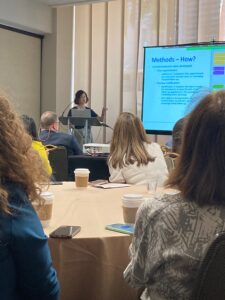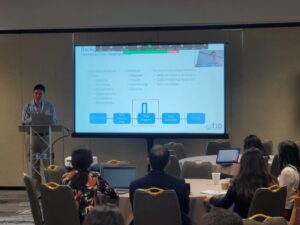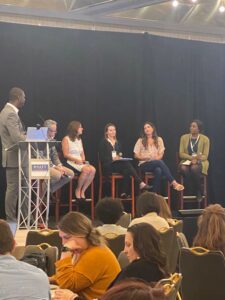
Sign up for a new account.
And get access to
The latest T1D content
Research that matters
Our daily questions
Sign up by entering your info below.
Reset Your Password
Don't worry.
We will email you instructions to reset your
password.
The T1D Exchange Quality Improvement Collaborative (T1DX-QI) Learning Session 2022 event takes place in Miami, FL, on November 7 and 8 — “T1DX-QI 52 Centers Strong: Implementation and Advocacy for Change.”
Members from 52 participating endocrinology clinics across the country come together to share insights on improving the care provided to people with diabetes — with the goal of improving quality of life and overall health.
Read Day 1 Session Highlights!
DAY 2 Session Highlights
Here are highlights from presentations throughout Day 2 — review the full agenda here.
Team-Science Approaches and the Value of Early T1D Screening
Presenter: Alberto Pugliese, MD
Arthur Riggs Diabetes and Metabolism Institute
Consultant for Provention Bio
 Over the last 35 years, explained Alberto Pugliese, MD, type 1 diabetes research has gained a significantly deeper understanding of the pathogenesis of this disease and the ability to identify target autoantigens, risk factors, biomarkers and more.
Over the last 35 years, explained Alberto Pugliese, MD, type 1 diabetes research has gained a significantly deeper understanding of the pathogenesis of this disease and the ability to identify target autoantigens, risk factors, biomarkers and more.
Pugliese highlights the collaborative effort between nearly a dozen different research organizations that contribute to these advancements, including:
- The Type 1 Diabetes Genetics Consortium (T1DGC) (NIDDK)
- The Type 1 Diabetes TrialNet (NIDDK)
- Immune Tolerance Network (ITN) (NIH)
- The Environmental Determinants of Diabetes in the Young (TEDDY) (NIDDK)
- Diabetes Prediction and Prevention (DIPP), Finland
- INNODIA, Europe
- Human Islet Research Network (HIRN) (NIDDK)
- Network for the Pancreatic Organ Donor with Diabetes (nPOD) (JDRF, Helmsley Charitable Trust)
- …and more.
In most recent years, the ability to test for the T1D-related autoantibodies potentially years before symptoms develop offers the potential to delay the progression of the disease with developing therapies like teplizumab.
Screening pancreatic organ donors through nPod has contributed significantly to understandings about the progression of T1D but the research opportunity with any individual ends if/when that pancreas is harvested for donation.
TrialNet has also led the way in this research, with goals of delaying, preventing, and modifying the progression of T1D through intentional screening in specific populations:
- Secondary prevention: antibody-positive relatives “at risk” of T1D
- Primary prevention: high genetic risk infants with evidence of autoimmunity
- New-onset T1D
- Further define epidemiology, natural history, and risk factors of T1D
- Advance translational science to lay groundwork for future generations of trials and clinical use
TrialNet has organized research with sites throughout the U.S., Europe, and Australia since 2000. The 2021 launch of the JDRF’s T1Detect screening program has made screening more easily accessible to the general public.
Pugliese highlighted a 2022 study, Screening for Type 1 Diabetes in the General Population — this research has contributed significantly to identifying the “1 in 10,000 people” who will likely test positive for T1D. He also pointed to recent research on the impact of teplizumab that offered significant data on delaying the disease — An Anti-CD3 Antibody, Teplizumab, in Relatives at Risk of Type 1 Diabetes.
With more than a dozen extensive studies focused on T1D progression, the team effort within multiple levels of T1D research has illustrated the importance of collaboration. Pugliese emphasized the importance of this continued work with the goal of developing effective prevention and treatment strategies.
 Artificial Intelligence Decision Support Enhances Engagement and Integration with Home Diabetes Care
Artificial Intelligence Decision Support Enhances Engagement and Integration with Home Diabetes Care
Presenter: Gajanthan Muthuvel, MD (virtual)
Cincinnati Children’s Hospital and University of Cincinnati
This research focused on making better use of the wealth of data in any given patient’s CGM and insulin pump to improve their HbA1c, time-in-range, and overall outcomes.
More than 80% of young people with T1D do not meet glycemic targets despite the advancements in diabetes technology available today. Meeting with providers once every three months with only so many minutes to sort through complex data isn’t effective.
With the implementation of an “enhanced care intervention” (ECI), patients and families can upload data on a monthly basis via Glooko to make effective adjustments in insulin doses with support from providers. DreamMed Advisor Pro supports this by aggregating and analyzing the data to support recommended adjustments and behavior modifications.
Patients ideal for ECI program include those who:
- Have had T1D for at least 6 months
- Are aged 7 to 24 years old
- Use an insulin pump and CGM (but not closed-loop)
- Have HbA1c level between 7 to 13%
This clinic set a goal to enroll at least 100 patients into this ECI program within six months. ECI includes automated email reminders to upload data from your device to Glooko for providers to review. Recommended insulin adjustments are conveyed via Glooko app and electronic medical record messaging via MyChart).
Patient and family feedback about the ECI was overwhelmingly positive. Staff feedback was more mixed. The impact on overall blood sugar levels was not as significant as expected with very slight changes in HbA1c and time-in-range.
The Diabetes, Data & Devices (D3) Education Program: Motivating Patient-Driven Review of Diabetes Data and Insulin Dose Changes
Presenter: Ashley Garrity, MPH
C.S. Mott Children’s Hospital and University of Michigan
The use of insulin pumps and continuous glucose monitors is increasing but patient-driven data review and insulin dose self-adjustments are still rare. This research aimed to better train patients and families on analyzing their data and making more frequent insulin adjustments.
To develop this training program, an interdisciplinary team is required:
- Pediatric endocrinologist
- Certified Diabetes Care and Education Specialist
- QI specialist, and graphic designer
Segments of the training program included:
- How to understand diabetes data and recognize patterns
- Understanding insulin and how it works
- Insulin dosing guidelines
- How behavior affects blood sugar levels
- How to adjust insulin doses
Through August 2022, 155 pediatric diabetes patients and families attended training. The average reduction in HbA1c was .42%. The reduction was higher for patients with starting HbA1cs above 9.0%. The D3 Education Program proved to be a powerful and effective method of increasing a patient or family’s ability to review their own diabetes data and make thoughtful adjustments.
Increasing Frequency of Clinic Visits among Medicaid Insured Children and Adolescents with Type 1 Diabetes
Presenter: Carla Demeterco-Berggren, MD, MPH
Rady Children’s Hospital and University of California, San Diego
 This research aimed to improve the frequency of clinic visits in youth with type 1 diabetes on Medicaid. There is a known relationship between frequent clinic visits and achieving target HbA1c levels. While the recommendation is clinic visits once every three months, only about 50% of patients on Medicaid meet this frequency.
This research aimed to improve the frequency of clinic visits in youth with type 1 diabetes on Medicaid. There is a known relationship between frequent clinic visits and achieving target HbA1c levels. While the recommendation is clinic visits once every three months, only about 50% of patients on Medicaid meet this frequency.
Using electronic health records, they identified patients with Medicaid, identifying these ethnicities and racial groups:
- 53% Hispanic
- 16% African American
- 3.2% Asian
- 11% refused to identify
- 16.1% White
Interventions to increase clinic visit frequency include:
- Monthly diabetes dashboard review
- Care navigator outreach
- Provider engagement
- Rescue visits slots added to NP schedule
- Care navigator appointment reminder calls
- Health maintenance created in the EHR
- Diabetes RN champion outreach call
This study is ongoing and has not collected results at this time.
Using Quality Improvement Techniques to Reduce Delayed Hospital Follow-up in Youth with Known T1DM Admitted in DKA
Presenter: Andie Kaminsky, RN, BSN, CPN, CDCES
Children’s Mercy Hospital and Kansas University School of Medicine
This research focused on the goal of effectively following-up with pediatric patients hospitalized for DKA within one month of being discharged from Children’s Mercy Diabetes Center.
- 63% of patients were scheduled for follow-up more than 28 days after DKA admission.
- 12% of patients were never scheduled for a follow-up after DKA admission.
- Goal: achieving 40% of patients admitted for DKA receiving follow-up within 28 days.
When reviewing the existing DKA-admission and follow-up process, the most likely failure to schedule follow-up was in the discharge paperwork. Too often, discharge paperwork includes no firm data and time for an appointment. Diabetes educators are often left with the burden of ensuring this appointment is eventually established.
Proposed ideal process:
- During DKA admission: CDE/provider reviews patients next follow-up appointment
- CDE meets with parents during DKA-admission
- Parent confirms availability and transportation for follow-up appointment with 28 days.
- Preferred provider is available
- Appointment is scheduled with preferred provider or next available
- CDE educates patients and parents on the follow-up date and time
- CDE relays follow-up appointment to primary care team
- Scheduled follow-up appointment is detail on discharge paperwork
When tested, this proposed process decreased the percentage of missed follow-up appointments from 52% to 35% within 12 weeks of implementation. 80% of patients successfully showed up to their follow-up appointments.
 A Program to Decrease Diabetic Ketoacidosis (DKA) Admissions:
A Program to Decrease Diabetic Ketoacidosis (DKA) Admissions:
Diabetes Wellness Program (DWP)
Presenter: Pediatric Diabetes Program, Roberto Izquierdo, MD
Upstate Golisano Children’s Hospital, Josline Diabetes, and Upstate Medical University
Pediatric DKA admissions have risen by 40% in the US with the most vulnerable groups at the highest risk. This research focused on reducing DKA admissions in pediatric patients with T1D through the Diabetes Wellness Program (DWP).
- Hospital charges per DKA admission have increased from $14,548 to $20,997
- Length of hospital stay has decreased from 2.5 to 2.2 days
- Patients with frequent ER visits have an average HbA1c over 14%
For patients ages 8 to 21 years old with multiple DKA admissions, the following process taking place over the course of six weekly phone calls is proposed:
- Ensure usage of MyChart
- Keep BG low or download device data
- Set SMART goals
- Assess the need for nutritional support
- Review ketone testing and sick-day education
- Review hypoglycemia protocol: use of glucagon, checking BG frequently, driving safety guidelines
- Review physical activity and BG management education
- Review technology, blood sugar patterns, making small adjustments, establishing routines
- Increase education on independent insulin dose adjustments
- Discuss long-term habits for long-term success
- Discuss “after hours” game
77% of the participants who completed this program significantly improved their quality-of-life scores based on results from the pre- and post-admission surveys.
100% of participants reported that the DWP helped them:
- Prevent future DKA admissions
- Improve overall quality of life
- Feel more confident in diabetes management
This program is proving effective in reducing DKA hospitalizations.
Implementation of a Wellness Program for People with Diabetes with HbA1c >9%
Presenter: Jeniece Ilkowitz, RN, MA, CDCES
Hassenfeld Children’s Hospital and Pediatric Diabetes Center at NYU Langone
This research focused on the efficacy of a 6-month Diabetes Wellness Program (WPD) specifically for pediatric patients with HbA1c levels over 9%.
Initial research revealed:
- A significant proportion of patients using a CGM have HbA1c levels below 9%
- A significant proportion of patients using an insulin pump have HbA1c levels below 9%
- A significant proportion of minority patients have HbA1c levels above 9% compared to non-minority group
- A significantly lower proportion of minority groups used a CGM compared to non-minority
- 61% of the risk ratio for minority status patients could be attributed to lack of diabetes technology
Details of the DWP for pediatric patients with HbA1c over 9% include:
- Each patient is paired with a CDCES
- CDCES or RN called to confirm their next appointment or schedule an appointment if none was scheduled
- DWP participants have weekly contact with CDCES for 6 weeks and attend a 6-week follow-up (options for contact: text, call, remote visit, in-person, etc.)
- Individualized interventions include:
- weekly CDCES check-in plan
- increased support to improve rates of diabetes technology
- behavioral health/psychosocial supports (neuropsychology evaluation, psychology, psychiatry, child-life)
- provide diabetes education/handouts/reinforcement
82 participants with HbA1cs over 9% were enrolled in the DWP.
- Median HbA1c before program: 10.6%
- Median age: 14 years old
- 70.2% identify as non-white
Results after 6-months in the DWP include:
- Median HbA1c at 6-months: 8.2%
- Interventions included:
- Introducing closed-loop insulin pump
- Increased diabetes education
- Increased behavioral health education
- Increased psychosocial care
- Increased communication
This program is proving effective in reducing HbA1c levels.
 Supporting Successful Health Care Transition from Pediatric to Adult Diabetes Care
Supporting Successful Health Care Transition from Pediatric to Adult Diabetes Care
Presenter: Faisal Malikd, MD, MSHS, Sarah Corathers, MD
Seattle Children’s Research Institute and University of Washing School of Medicine
Cincinnati Children’s Hospital and University of Cincinnati Department of Pediatrics
With the goal of transitioning pediatric patients with T1D to adult diabetes care, this research aimed to identify a successful timeline and necessary support. This is a critical timeframe when patient care can suffer due to a lack of transition support and process.
- Over 70% of pediatric clinics have a formal transition policy.
- Over 40% of adult clinics were unsure if they had a formal transition policy.
- Less than 40% of pediatric clinics said their transition policy was created with input from patients.
- Less than 40% of pediatric clinics use a transition readiness patient questionnaire.
- Only 27% of pediatric clinics have a process in place to complete the transfer of care.
Depending on the patient’s individual diabetes education and management habits, this transition can begin anywhere between 14 to 21 years old, based on success from the Adolescent and Young Adult Diabetes (AYA) program from University of Washington State School of Medicine (UWMDI).
Factors to consider throughout the transition of pediatric to adult care include:
- A clinic’s transition and care policies
- Tracking and monitoring patient’s health data
- Reflecting on each individual patient’s transition readiness
- Planning that transition ahead of time and discussing with patient
- The actual transition to adult care
- Confirming transfer completion between clinics
The providers on any successful transition team should include:
- Endocrinologist
- Dietician
- Social worker
- Diabetes educator
- Psychologist
The AYA program proposes using their Diabetes Program Registry READDY questionnaire to assess readiness and monitor the transition process for every patient.
Technology, Device Use, and TIR/A1C Targets
Presenters: Nudrat Noor, PhD, MPH, Mark Clements, MD, PhD, and Francisco Pasquel, MD, MPH (virtual)
Children’s Mercy Kansas City Hospital and University of Missouri-Kansas City School of Medicine
This research focused on the impact of diabetes technology on HbA1c levels and time-in-range (TIR). Cohort details include:
- 1,867 participants
- Median HbA1c level: 8.1%
- 728 were eligible for depression screening / 452 actually screened
- 79% used a CGM
- 7.2% of non-CGM users checked blood sugar at least 4x per day
- 68.8% used an insulin pump / 30.3% on multiple daily injections
- 99.1% were effectively administering daily insulin
HbA1c levels correlate closely with the “Six Habits” of diabetes self-management:
- Using a CGM or checking blood sugar at least 4x per day with glucometer
- Giving at least 3 rapid-acting boluses per day
- Using an insulin pump
- Delivering mealtime insulin before meals
- Reviewing glucose data at least once between clinic visits
- Self-adjusting insulin doses at least once between clinic visits
- (Future habit to propose when ready: Improving overall diet)
- (Future habit to propose when ready: Increase daily physical activity)
The average HbA1c of patients engaged in all six habits = 8%. Patients with the fewest habits had average HbA1c levels around 12%.
Remote Continuous Glucose Monitoring with a Computerized Insulin Infusion Protocol for Critically Ill Patients in a COVID-19 Medical ICU: Proof of Concept
Presenter: Francisco J. Pasquel, MD, MPH
Emory University School of Medicine
This research focused on a proposed method of using CGM technology and computerized insulin infusion in patients hospitalized with COVID-19 to better monitor blood sugar levels while reducing patient contact between the nursing staff. This also reduced the need for nurses to prepare with PPE gear before entering the patient’s room and reduced their risk of contracting COVID-19.
Implementing this concept requires the following:
- Smartphone within 20 feet of the patient to receive Bluetooth signal
- Insulin pump management established with access from outside of patient’s room
- Ability to transmit glucose data wirelessly from CGM, including preset alarms
- EHR documentation and validation
- Algorithm for computerized insulin infusion
- Remote monitoring by the endocrinology and pharmaceutical team via Follow App
- Dashboard with glucose/insulin data for nursing staff to monitor multiple patients
Summary reports can be easily pulled for any individual patient through Dexcom Clarity to review time-in-range, standard deviation, etc.
This concept achieves the following benefits to both the patient and healthcare team:
- Reduction in bedside encounters between nurse and patient
- Reduction in need for PPE gear
- Ability to achieve and maintain adequate blood sugar goals
- Reduction in finger sticks and potential blood loss due to intravenous samples
- Increased monitoring ability thanks to remote real-time data
- Improved overall evaluation of a patient’s well-being and safety
This concept can be implemented rapidly during emergency situations, like COVID-19, in a collaborative environment.
 Click here to request more information about how your clinic can join the T1D Exchange Quality Improvement Collaborative.
Click here to request more information about how your clinic can join the T1D Exchange Quality Improvement Collaborative.







